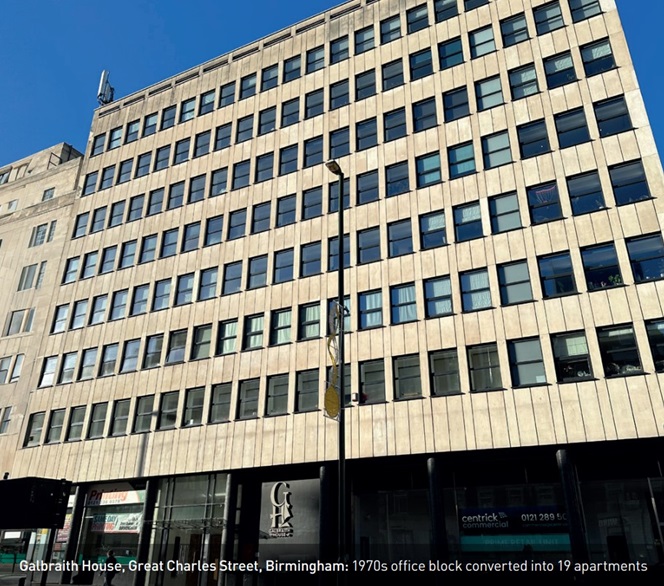Proposed amendments to permitted development right legislation, combined with pressures caused by falling office values, could unlock a new wave of office-to-residential conversions. This has the potential to aid the ongoing rebalancing of regional markets towards less but higher quality office space.
Download the Regional Office Market Report in full 2023 here →
The first wave recedes
It is just over a decade since permitted development rights enabling changes of use from offices to residential without planning permission were first introduced in England. Initially put in place on a temporary basis for three years, office-to-residential PD rights were made permanent in 2016 and have been subsequently amended by a series of legislation.
A surge of office-to-residential conversions followed the initial introduction of permitted development rights in 2013. At the peak, 17,751 new homes were delivered in 2016-17 in England via changes of use from offices, but this figure has dwindled by more than half in recent years.
Much of the ‘low hanging fruit’ appeared to be picked off in the early days of the PD right, with developers seizing on the easiest-to-convert obsolete office buildings. Activity was largely concentrated on London and the South East, where high residential values aided viability, with Bristol being the one notable focus in the regions.
The build and amenity quality of the first wave of office-to-residential conversions attracted criticism, with some developers accused of cramming small flats lacking space and natural light into poorly converted office blocks. However, more recent legislation has ensured that permitted development is now subject to provisions for adequate natural light and Nationally Described Space Standards; while an additional attempt to improve quality came in 2020 through the establishment of a separate PD right allowing some vacant office properties to be demolished and completely replaced with residential buildings.
Since 2021, office-to-residential change of use has come under ‘Class MA’ rights, covering the wider Use Class E (commercial, business and services). These rights came with big restrictions, limiting the floorspace in buildings changing use to 1,500 sq m and establishing a vacancy requirement.
However, future reforms appear to be on the cards, with the Department for Levelling Up, Housing and Communities holding a consultation earlier this year on proposed ‘additional flexibilities’ aimed at supporting housing delivery. Potential changes affecting office-to-residential conversions include the removal of the vacancy requirement; and proposals to either double the amount of floorspace that can be changed to 3,000 sq m, or remove the cap completely.
NET ADDITIONAL DWELLINGS VIA OFFICE-TO-RESIDENTIAL PDR

| OFFICE-TO-RESIDENTIAL PDR – KEY DATES | |
| 2013: CLASS J |
The Town and Country Planning (General Permitted Development) (Amendment) (England) Order 2013 A permitted development right allowing changes of use from offices to residential is introduced for the first time. Initially called the Class J right, it is put in place for a temporary period of three years. Some restrictions are stipulated, relating to transport impacts, contamination risks and flooding risks. |
| 2016: CLASS O |
The Town and Country Planning (General Permitted Development) (England) (Amendment) Order 2016 The temporary office-to-residential permitted development right is made permanent, and becomes known as the Class O right. |
| 2020: CLASS ZA |
Town and Country Planning (General Permitted Development) (England) (Amendment) (No. 3) Order 2020 A new and separate permitted development right, Class ZA, is introduced allowing detached office buildings to be demolished and replaced by new residential properties. The old building must have a footprint no larger than 1,000 sq m; be no higher than 18 m; have been built before 1990; and been vacant for at least six months. |
| 2021: CLASS MA |
The Town and Country Planning (General Permitted Development etc.) (England) (Amendment) Order 2021 The new Class MA permitted development right supersedes Class O, providing for the change of use of premises in the broader Use Class E (commercial, business and services) to residential. The right stipulates that buildings must have floorspace of no more than 1,500 sq m; have been vacant for at least three continuous months; and have spent at least two years in Class E. |
| 2023: CONSULTATION |
Consultation on Additional Flexibilities to Support Housing Delivery The government holds a consultation on reforms to permitted development rights, including proposals to double the floorspace that can change use under Class MA rights to 3,000 sq m; and to remove the requirement that premises must have been vacant for at least three continuous months. |
Rob Reeds, Planning Consultant at Lambert Smith Hampton, said:
"For our developer and investor clients, changes to permitted development right legislation are likely to be a welcome move. If done correctly, the conversion of offices to residential accommodation can breathe new life into our high streets and redundant office stock which is still suffering from the pandemic. The challenge is to ensure this can be done whilst meeting key quality metrics and ensuring new uses can integrate well into the communities of which they are a part."

Regional second wave?
Recent changes to PD rights have come amid the wider turmoil of the COVID period and, subsequently, rising interest rates. While this turbulence has had a restrictive impact on office-to-residential conversions, it has also shifted the dynamics of the markets in ways that have bolstered the arguments for change of use in many locations, particularly for secondary offices.
Office capital values have tumbled by c. 20% in many key regional centres over the year to Q3 2023, but residential values have remained relatively robust. As a result, significant margins have been established between residential and office values in multiple cities, and the gaps to secondary office values are now particularly large.
While higher residential values have historically made conversions most viable in London and the South East, there is now a strengthened case in regional markets. Average city centre residential values are 32% higher than office values in Manchester; and 15% higher in Birmingham. This is a direct reversal of the trends seen a decade ago, and it may mean that the next wave of conversions is led by the regions, not London.
Conversions to build to rent assets could be a particularly attractive option in regional cities, with this sector having especially strong rental growth prospects due to a growing supply/demand imbalance in the residential rental market. Office blocks may be most suitable for conversion to BTR-led schemes where they have existing spaces that could be adapted into reception areas and resident amenities.
A word of caution is necessary, however, as Local Planning Authorities in the regions are starting to consider options to withdraw permitted development rights via Article 4 directions. These have been prevalent in London and the South East, with some LPAs seeking to apply whole-borough Article 4 directions, and it remains to be seen whether cities such as Manchester, Birmingham and Leeds will follow suit.
Jonathan Scott, Office Agent and Capital Markets Director at Lambert Smith Hampton, said:
"In the current environment, permitted development has the potential serve a number of ends. Principally, there is a surplus of secondary offices across the country that are no longer fit for purpose as occupiers target best-in-class offices. By increasing the floorspace limits as proposed by the government, more offices can begin again to be converted to residential under permitted development rights, and this untapped supply of buildings has the potential to address the acute housing shortage the country is currently facing."
RESIDENTIAL VS OFFICE CAPITAL VALUES, TIER 1 CITIES (£ PER SQ FT)

AVERAGE CAPITAL VALUES (£ PER SQ FT)

Local Planning Authority overview, Head of Planning at a sub-regional planning authority, says:
"Concerns over the role of PD rights and the limitations of Local Authorities to control and manage these changes will continue to present a challenge. Quality controls in terms of space standards and light have improved outcomes but the lack of mechanisms to require contributions such as affordable housing and other works is problematic and hampers our ability to deliver services to local people."

Rebalancing office markets
With occupier demand increasingly focused on prime office space that suits post-COVID requirements, there is a need for many regional markets to become leaner and more concentrated on high quality space. A considerable amount of secondary space will either have to be repositioned as better quality offices, or be completely removed from the market via change of use to residential.
Permitted development rights are an important supporting factor in the rebalancing of office markets, and their usefulness is demonstrated by a comparison between England and the other UK nations, where PD regimes are more restrictive. The absence of office-to-residential PD rights in Scotland, for example, is one of the major reasons why cities such as Glasgow have large surpluses of vacant peripheral grade B space that developers have been unable to repurpose.
The first wave of office-to-residential conversions was directly driven by legislative change but, if there is to be a second wave, it may result more from shifting values and changing market dynamics. Nonetheless, proposed changes to PD rights could underpin increased activity by extending their potential application to a wider range of buildings, including large office blocks above the current 1,500 sq m floorspace limit. Greater PD flexibilities will be key to providing landlords and developers with an increased range of tools and options when assessing future plans for underperforming regional office assets.
Download the Regional Office Market Report in full 2023 here →
Get in touch


Email me direct
To:
REGISTER FOR UPDATES
Get the latest insight, event invites and commercial properties by email







